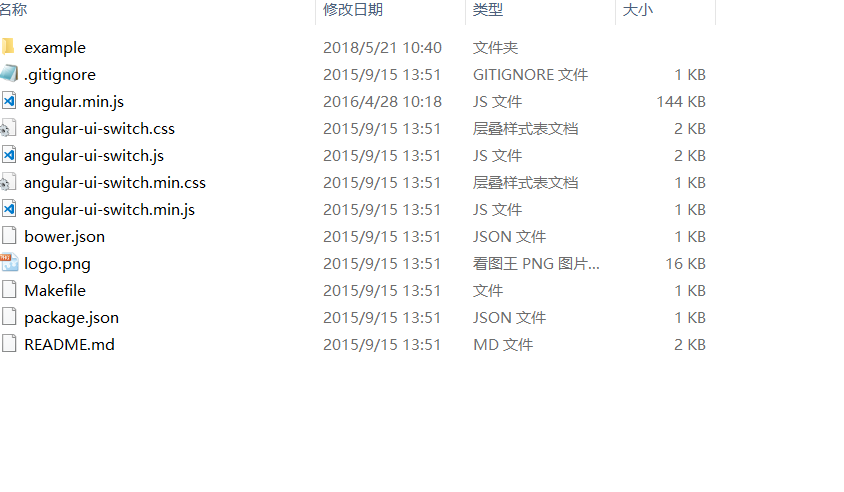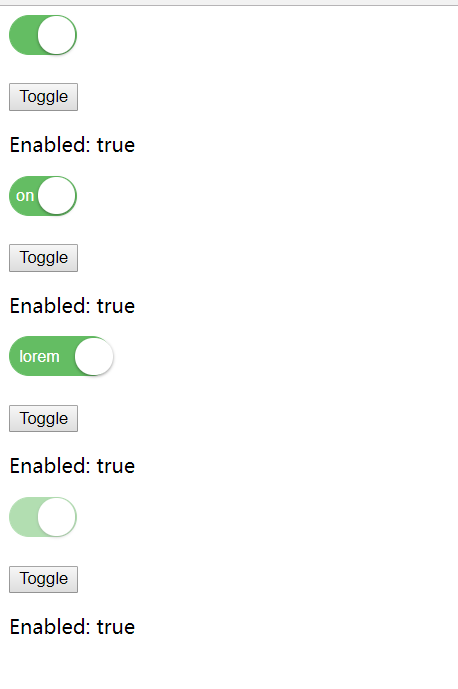方法一(使用指令)
1.指令(angular-ui-switch.js)
angular.module('uiSwitch', []) app.directive('switch', function(){ return { restrict: 'AE' , replace: true , transclude: true , template: function(element, attrs) { var html = ''; html += '<span'; html += ' class="switch' + (attrs.class ? ' ' + attrs.class : '') + '"'; html += attrs.ngModel ? ' ng-click="' + attrs.disabled + ' ? ' + attrs.ngModel + ' : ' + attrs.ngModel + '=!' + attrs.ngModel + (attrs.ngChange ? '; ' + attrs.ngChange + '()"' : '"') : ''; html += ' ng-class="{ checked:' + attrs.ngModel + ', disabled:' + attrs.disabled + ' }"'; html += '>'; html += '<small></small>'; html += '<input type="checkbox"'; html += attrs.id ? ' id="' + attrs.id + '"' : ''; html += attrs.name ? ' name="' + attrs.name + '"' : ''; html += attrs.ngModel ? ' ng-model="' + attrs.ngModel + '"' : ''; html += ' style="display:none" />'; html += '<span class="switch-text">'; /*adding new container for switch text*/ html += attrs.on ? '<span class="on">'+attrs.on+'</span>' : ''; /*switch text on value set by user in directive html markup*/ html += attrs.off ? '<span class="off">'+attrs.off + '</span>' : ' '; /*switch text off value set by user in directive html markup*/ html += '</span>'; return html; } } });
2.css(angular-ui-switch.css)
.switch {
background: #fff;
border: 1px solid #dfdfdf;
position: relative;
display: inline-block;
box-sizing: content-box;
overflow: visible;
52px;
height: 30px;
padding: 0px;
margin: 0px;
border-radius: 20px;
cursor: pointer;
box-shadow: rgb(223, 223, 223) 0px 0px 0px 0px inset;
transition: 0.3s ease-out all;
-webkit-transition: 0.3s ease-out all;
top: -1px;
}
/*adding a wide width for larger switch text*/
.switch.wide {
80px;
}
.switch small {
background: #fff;
border-radius: 100%;
box-shadow: 0 1px 3px rgba(0,0,0,0.4);
30px;
height: 30px;
position: absolute;
top: 0px;
left: 0px;
transition: 0.3s ease-out all;
-webkit-transition: 0.3s ease-out all;
}
.switch.checked {
background: rgb(100, 189, 99);
border-color: rgb(100, 189, 99);
}
.switch.checked small {
left: 22px;
}
/*wider switch text moves small further to the right*/
.switch.wide.checked small {
left:52px;
}
/*styles for switch-text*/
.switch .switch-text {
font-family:Arial, Helvetica, sans-serif;
font-size:13px;
}
.switch .off {
display:block;
position: absolute;
right: 10%;
top: 25%;
z-index: 0;
color:#A9A9A9;
}
.switch .on {
display:none;
z-index: 0;
color:#fff;
position: absolute;
top: 25%;
left: 9%;
}
.switch.checked .off {
display:none;
}
.switch.checked .on {
display:block;
}
.switch.disabled {
opacity: .50;
cursor: not-allowed;
}
3.在apps.js中注入
var app = angular.module('app', ['uiSwitch'])
4.index.html引入相关文件
<link rel="stylesheet" href="../angular-ui-switch.css"/> <script src="../angular.min.js"></script> <script src="../angular-ui-switch.js"></script> <script src="app.js"></script>
5.应用:
<form data-ng-controller="MyController"> <switch name="enabled" ng-model="enabled" ng-change="changeCallback"></switch> <p> <button ng-click="enabled=!enabled">Toggle</button> </p> <p> Enabled: {{ enabled }} </p> <!--Examples of using switch text on/off values. These values can be anything. First example shows basic on/off--> <switch name="onOff" ng-model="onOff" on="on" off="off"></switch> <p> <button ng-click="onOff=!onOff">Toggle</button> </p> <p> Enabled: {{ onOff }} </p> <!--Examples of using the nonsense words lorem/ipsum in the on/off values. Because these are wider, added an option "wide" class to allow for more room--> <switch name="yesNo" ng-model="yesNo" on="lorem" off="ipsum" class="wide"></switch> <p> <button ng-click="onOff=!onOff">Toggle</button> </p> <p> Enabled: {{ yesNo }} </p> <!--Examples of using switch disabled states. --> <switch name="disabled" ng-model="disabled" disabled="true"></switch> <p> <button ng-click="disabled=!disabled">Toggle</button> </p> <p> Enabled: {{ disabled }} </p> </form>
6.附录---目录结构

7.效果图:

方法二(使用背景图和ng-class)
html
<span class="wrap" ng-class="{true:'on',false:'off'}[isOn]" ng-click="isOn = !isOn"></span>
css
.wrap{
display:block;
68px;
height:40px;
background-size: cover;
cursor: pointer;
}
.on{
background:url(../on.png) no-repeat;
}
.off{
background:url(../off.png) no-repeat;
}
js
$scope.isOn = false;//默认为关闭状态
效果:

相关链接:
个人资料:
作者:smile.轉角
QQ:493177502